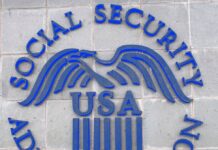
The following is a transcript of a report from “Full Measure with Sharyl Attkisson.” Watch the video by clicking the link at the end of the page.
Whether it’s helping businesses, supporting hospitals and schools, or paying the unemployed, a record amount of money is being spent on Covid-19-related assistance in the U.S. But for every taxpayer dollars that’s sent to someone who needs it, an unknown amount of money is lost to waste and fraud. Today, we look at some of the biggest cons so far – and who’s looking for all the crooks.
Texas businessman Dinesh Sah is one of the biggest known Covid scamsters so far. He’s sentenced to 11 years in prison for fabricating documents applying for nearly $25 million for nonexistent businesses and workers. He spent the taxpayer money on homes and luxury cars.
Sharyl: What was your first clue that there was going to be an element, a large element, of fraud possible?
Mike Ware: As soon as we started to hear what the numbers were in terms of how much money was going to be allocated to these programs.
Mike Ware is the Inspector General of the Small Business Administration, which is in charge of administering Covid-19 relief for businesses. With Ware’s help, we’re taking a deep dive into all the fraud that’s come with it.
Ware: Immediately, we knew it, because we had a large body of previous work that we had conducted over decades.
The amount of Covid funds pouring into the U.S. economy is mind-boggling.
March 6, 2020: $8.3 billion tax dollars for vaccines and testing.
Followed by (March 18 2020): $225 billion for testing, sick leave, and food aid.
(March 27 2020): $2.2 trillion, including stimulus payments, expanded unemployment benefits and the Paycheck Protection Program.
(April 24 2020): $483 billion more for the Paycheck Protection Program and Covid testing.
(Dec. 28 2020) $920 billion, including stimulus payments, billions more for the Paycheck Protection Program, vaccines, schools, and unemployment.
And (March 11, 2021) $1.9 trillion, including more stimulus payments, and more money for schools and vaccines.
That’s about six trillion dollars to date. Far bigger than the entire economies— the total of all goods and services produced (GDP)— of nearly every nation on the planet.
The incredible sums of money were rushed out the door, say watchdogs, without proper oversight in place.
Ware says The Small Business Administration quickly got flooded with applications.
Ware: What happened was, from the onset, they were doing batch processing. So, I think it was 17 minutes, an officer had to review a file, in order to meet these things, because the batches were coming in 200 at a time. That was one of the schemes we noticed when we started to track what the fraudsters were actually saying “Bombard them. Throw as many at the wall as possible, and some will get through.”
Suspicious patterns, such as hundreds of loan applications from the same internet address, merited follow up, he says. But efforts to implement controls were met with resistance by leadership at the Small Business Administration or SBA.
Ware: What we do know is this, from the onset, they didn’t take that seriously. So It was, “But it could be a reason why. There could be a viable reason why. Our role here is to get this money out.”
Sharyl: Who’s saying that?
Ware: The leadership at SBA at the time. It was like, “There are red flags, and I need you to flag those loans, and do the due diligence to make sure that they’re going to the people who are eligible to receive them.”
One early hint of the staggering scale of crime came as the Inspector General’s hotline quickly surged from 900 complaints in a year, pre-Covid, to 155,000 in 2020.
Ware: This is more than we’ve ever had total. What has been incredibly helpful to us is, “Hey, our employer got this money, and he bought a car, and he bought a house, and he bought this, and we have not been paid.” That’s the type of things when we triaged this information, that’s what we’re going after immediately.
So far, the Justice Department has charged more than 750 people in fraud cases involving $614 million dollars. But auditors assume most criminals are never caught. And there are as many scenarios as there are fraudsters.
Virginia Smith pleaded guilty to fraudulently getting unemployment benefits for at least 22 prison inmates.
Eric Ahiekpor admitted stealing Covid-relief funds to buy boats while awaiting trial for a multi-million dollar internet romance scam.
Sheila Dunlap allegedly conspired with her son, who was in prison, to get the ID information of 9,000 people to illegally claim payments for almost $145-thousand dollars.
Andrew Tezna a senior NASA executive and Colombia native was sent to prison after spending nearly $300-thousand dollars in Covid relief money on a $6,000 French bulldog, a $50,000 swimming pool loan, and six figures’ worth of personal debt. All while Tezna earned more than $180,000 a year helping oversee finances at NASA.
Dana McIntyre is accused of falsely claiming he employed almost 50 people at his pizza shop. He got more than a half million dollars in tax money, sold the restaurant, and, prosecutors say, went on a spending spree that included cars and an Alpaca farm.
Five Venezuelans allegedly used fake IDs to steal $800-thousand dollars in Covid-19 relief checks.
A Florida couple was convicted in a $1.1 million fraud scheme. They got taxpayer money for their farms, two businesses and 62 employees—none of which existed.
One giveaway should have been that the land they claimed to be farming was in the yards of two small urban Miami homes.
Lebnitz Tran is charged with stealing $3.6 million in taxpayer funds, using some of it to buy cryptocurrency and a $100,000 Tesla.
Michael Lain admitted submitting 70 fraudulent loan applications in a $4 million scheme.
Azhar Sarwar Rana, pleaded guilty to more than $5 million in fraud— buying stocks, paying luxury car expenses, and sending hundreds of thousands of dollars to his home country of Pakistan.
Engineer Shashank Rai admitted to a $13 million scheme claiming 250 employees, when he had none.
Chinese national Muge Ma pleaded guilty in a $20 million Covid relief money fraud scheme.
And Hasan Hakim Brown admitted to working with co-conspirators to steal $24 million in Covid-19 relief funds.
Sharyl: You published a flash report in May, which resulted in legislative changes. It said: “Based on prior work, and analysis of loan data, you identified at the time, 70,835 loans, $4.6 billion in potentially fraudulent PPP loans. That’s a huge number. $4.6 billion.
Ware: Yeah, it’s a huge number. That’s the way I look at it. I look at a trade up at numbers. Other people like to dissect it, “Well, it’s only X amount of percent of the pool.” I say, “Well, it’s $4.6 billion.” And it was the banks, upfront, who were partnering with us from the onset to say, “Hey, we have a problem. These deposits are going into their accounts from the Economic Injury Disaster Loans, EIDL Program, where these people never had a business. We asked them a simple question, ‘You are a business owner?’ ‘No.’ It’s because it was up to $10,000 at the time.
Sharyl: They have to have owned a business to get the loan, supposedly?
Mike Ware : They have to have owned a business. Supposedly. Should have had employees, as well. To get the 10,000, because of SBAs rules, proven that you had at least 10 people. They were, “Well, what is this money for?” Folks weren’t able to even say what the money was for. “We were just told the government was giving out money.”
In terms of perspective, similar tales of con-artistry have emerged after every giant sum of federal taxpayer money has left the Treasury.
There was the banker who admitted spending $381,000 in bank bailout funds to buy a waterfront condo in Florida. The SAT tutor sent to prison in a $3 million swindle of stimulus funds given under President Obama’s Recovery Act.
And a reported billion dollars in relief fraud after Hurricane Katrina, with taxpayer money spent on diamonds, porn videos and Hawaiian vacations.
Congress could put permanent safeguards in place that automatically activate when emergency money goes out the door, Ware says, but no such measure is being considered ensuring there will be lots to keep prosecutors and the Inspector General busy in the foreseeable future.
Ware: The employees of the Small Business Administration worked hard to get the money out to people who needed it so desperately, but the balance to be struck between the speed of that, in a control environment that ensures that goes to the people who really need it and who are eligible, that balance was just a little bit off center, but it’s something that is really being focused on currently.
Sharyl (on-camera): You may wonder how much money investigators are able to get back from the fraudsters they catch. That varies widely. When I interviewed Ware, he said the Small Business Administration had recovered about $1.9 billion.
WATCH FULL STORY HERE: COVID FRAUD








